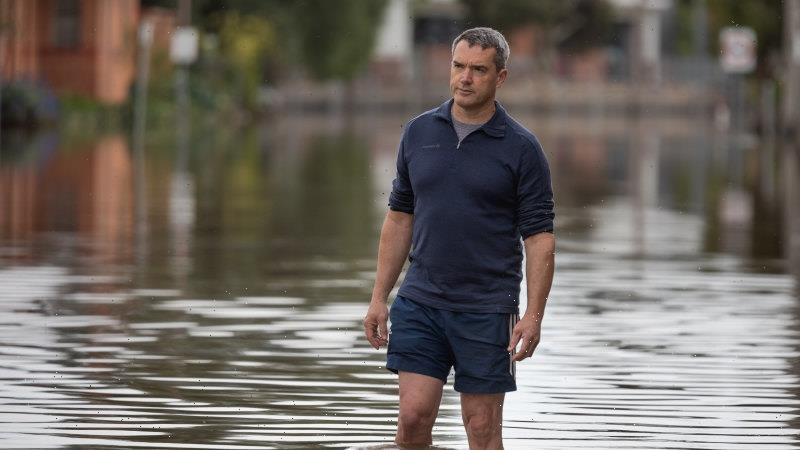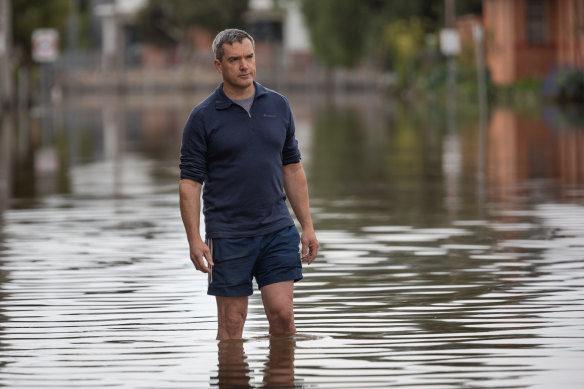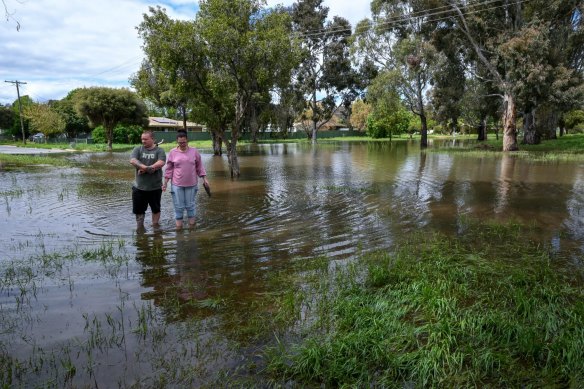
Emergency app? In the flood zone, we get news from the local paper and Facebook
October 19, 2022There were 10 earwigs behind a spanner when I pulled it off a nail on the wall in the workshop today. Then I found a cockroach in the chocolate. And yesterday, there were kangaroos hopping in front of traffic in the main street of Mooroopna, escaping the floods.
We fled to Ardmona in central Victoria from Northcote, just outside Mooroopna, last year, seeking space after the lockdowns. We’ve now found ourselves captured in a verdant prison, walled in by water.
Former Age journalist Tim Winkler, who now lives in Ardmona, says the local newspaper and Facebook groups are the best source of information on the floods.Credit:Jason South
I lost my best pair of shoes covering floods in Gippsland in the ’90s for The Age, wading in for fleeting interviews with residents. It was surreal, going from the monolithic brown brick office in Spencer Street to a series of drenched towns, where houses, once solid, looked fragile and defiled by mud.
Now, I am on the other side. I see helicopters, but the only useful news comes from Facebook and the small Shepparton News team.
Hydrologists built a highly detailed map of flooding, while also recognising that changes in land development and climate change have made forecasts of who gets inundated and who stays dry very complex.
Our family has been lucky so far. The predicted high-water mark would have brought floodwaters to within about 20 metres of our house, but wasn’t quite attained. Many others are not so lucky. Generations of my ancestors have lived in this area, but each new flood brings new lessons. I have already learned a few new things.
Local residents walk through flooded Howe Street in Mooroopna on Saturday.Credit:Eddie Jim
Firstly, power and water are never of consequence in our lives until they are gone. Why do we wire our houses so that when the grid goes down, thousands of homes sit with powerful solar panel systems on their roofs still generating energy, but they can’t use any of it? We must start setting ourselves up smarter, especially as more catastrophic weather events are forecast to occur.
Second, I live 100 metres from an amazing orchard, with some of the world’s best fruit, about one kilometre from a tomato producer, and down the road from some world-class dairies. But all the shops are shut, and we are surviving on what we scrounged when supermarkets were open last Friday. The scarcity is ironic given we’re in the heart of the nation’s food bowl.
Thirdly, communication is dreadful. The Shepparton News provided free access to an excellent blog during COVID and again during this crisis; their blog is by far the best source of information locally, supplemented with more specific information from local Facebook groups.
Drone pictures have been invaluable in helping people understand where floods are greatest, what property is damaged and what water is coming their way. But drones are discouraged by emergency services who understandably want clear approaches for helicopters, but then appear to share no useful footage.
Victoria’s emergency apps spit out over-frequent warnings which everybody I know had turned off, in a classic “boy who cried wolf” scenario. Even worse, in a community as richly diverse as ours, the communication for people who speak languages other than English has been very poor.
We spent part of Saturday afternoon jacking up the furniture of two workers from Taiwan who had only heard of the flood 30 minutes before. Their flat was inundated a few hours later. There are many similar stories with people from non-English backgrounds.
For us out in Ardmona, we study a range of maps and charts, discuss which might be most reliable and work out that we might as well study the entrails of a goat for all the help much of it is, in understanding whether we are about to be flooded or not.
Fourthly, the speed of the state and federal government response has been impressive, providing immediate help and funds, even before floodwaters recede. Credit where credit’s due. But 30 years after I waded through floods in Gippsland, the deficit-focused mentality that drives disaster recovery is still the same.
As a nation, we will throw some money at it, to try to restore it like it was before. Which in the case of Mooroopna is one of the poorest socio-economic areas in Victoria, with a main street that was just reviving, and a community just starting to find new opportunities for work and business. The coffee is great at more than one place. My favourite barbers in the main street barely rest, as customers gather at their door.
Handouts and new roads are vital, but true disaster recovery requires vision. Council and government giving opportunities for local businesses to be favoured for local contracts. A reduction in red tape. Renewable energy industries that make the most of the solar hours that the area thrives on.
The future of the Goulburn Valley will be strong, but it will thrive much faster with coordination and vision alongside the recognition that for some, additional support will be required for an extended period to enable them to establish life on an even keel once more.
Most Viewed in National
From our partners
Source: Read Full Article




